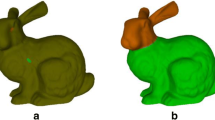Abstract
The mesh quality is of vital importance to obtain the numerical results precisely. Poorly shaped or distorted elements can be produced by automatic mesh generation tools. In this article, the mesh smoothing algorithm based on the Markov chain Monte Carlo method is proposed to improve the quality of the mesh. The movement of nodes position is converted to a stochastic process to seek the best position for the element quality. Compared with the widely known Laplacian smoothing and optimization-based smoothing techniques, the mesh quality by the proposed method is found better than these methods. Examples are performed to illustrate the applicability of the approach. The numerical results show that the proposed algorithm is effective and valuable.




















Similar content being viewed by others
References
Vartziotis D, Wipper J, Papadrakakis M (2013) Improving mesh quality and finite element solution accuracy by GETMe smoothing in solving the Poisson equation. Finite Elem Anal Des 66:36–52
Xu H, Newman TS (2006) An angle-based optimization approach for 2D finite element mesh smoothing. Finite Elem Anal Des 42:1150–1164
Freitag LA, Ollivier-Gooch C (1997) Tetrahedral mesh improvement using swapping and smoothing. Int J Numer Meth Eng 40:3979–4002
He Z, Zhang G, Deng L, Li E, Liu G (2015) Topology optimization using node-based smoothed finite element method. Int J Appl Mech 7:1550085
Parthasarathy V, Kodiyalam S (1991) A constrained optimization approach to finite element mesh smoothing. Finite Elem Anal Des 9:309–320
Ohtake Y, Belyaev A, Bogaevski I (2001) Mesh regularization and adaptive smoothing. Comput Aided Des 33:789–800
Durand R, Pantoja-Rosero BG, Oliveira V (2019) A general mesh smoothing method for finite elements. Finite Elem Anal Des 158:17–30
Aubry R, Dey S, Karamete K, Mestreau E (2016) Smooth anisotropic sources with application to three-dimensional surface mesh generation. Eng Comput 32:313–330
El Ouafdi AF, El Houari H, Ziou D (2015) Anisotropic adaptive method for triangular meshes smoothing. IET Image Proc 9:516–526
Ruiz-Girones E, Roca X, Sarrate J, Montenegro R, Escobar JM (2015) Simultaneous untangling and smoothing of quadrilateral and hexahedral meshes using an object-oriented framework. Adv Eng Softw 80:12–24
Field DA (1988) Laplacian smoothing and Delaunay triangulations. Commun Appl Numer Methods 4:709–712
Vartziotis D, Papadrakakis M (2017) Improved GETMe by adaptive mesh smoothing. Comput Assisted Methods Eng Sci 20:55–71
Vartziotis D, Bohnet D, Himpel B (2018) GETOpt mesh smoothing: putting GETMe in the framework of global optimization-based schemes. Finite Elem Anal Des 147:10–20
Dassi F, Kamenski L, Farrell P, Si H (2018) Tetrahedral mesh improvement using moving mesh smoothing, lazy searching flips, and RBF surface reconstruction. Comput Aided Des 103:2–13
Lee EK, Shin M, Kim J (2018) Improved simultaneous mesh untangling and quality improvement methods of 2D triangular meshes. Int J Comput Methods. https://doi.org/10.1142/S0219876218501190
Freitag LA (1997) On combining Laplacian and optimization-based mesh smoothing techniques. ASME Appl Mech Division Publ AMD 220:37–44
Hansbo P (1995) Generalized Laplacian smoothing of unstructured grids. Commun Numer Methods Eng 11:455–464
Ji Z, Liu L, Wang G (2005) A global laplacian smoothing approach with feature preservation. In: Ninth international conference on computer aided design and computer graphics (CAD-CG’05). IEEE, p 6
Mittal K, Fischer P (2018) Mesh smoothing for the spectral element method. J Sci Comput 78(2):1152–1173
Freitag LA, Plassmann P (2000) Local optimization-based simplicial mesh untangling and improvement. Int J Numer Meth Eng 49:109–125
Freitag LA, Knupp PM (2002) Tetrahedral mesh improvement via optimization of the element condition number. Int J Numer Meth Eng 53:1377–1391
Dai C, Liu HL, Dong L (2014) A comparison of objective functions of optimization-based smoothing algorithm for tetrahedral mesh improvement. J Theor Appl Mech 52:151–163
Karman SL (2016) Adaptive optimization-based improvement of tetrahedral meshes. AIAA J 54:1578–1590
D’Elia M, Ridzal D, Peterson KJ, Bochev P, Shashkov M (2016) Optimization-based mesh correction with volume and convexity constraints. J Comput Phys 313:455–477
Freitag LA (1997) On combining laplacian and optimization-based mesh smoothing techniques. In: Symposium on Joint ASME, ASCE
Fabritius B, Tabor G (2016) Improving the quality of finite volume meshes through genetic optimisation. Eng Comput 32:425–440
Peng W, Lu DT, Huang T, Wang L (2015) Hexahedral mesh smoothing via local element regularization and global mesh optimization. Comput Aided Des 59:85–97
Lin TJ, Guan ZQ, Chang JH, Lo SH (2014) Vertex-ball spring smoothing: an efficient method for unstructured dynamic hybrid meshes. Comput Struct 136:24–33
Knupp P (2012) Introducing the target-matrix paradigm for mesh optimization via node-movement. Eng Comput 28:419–429
Park J, Shontz SM (2010) Two derivative-free optimization algorithms for mesh quality improvement. Proc Comput Sci 1:387–396
Walton S, Hassan O, Morgan K (2013) Reduced order mesh optimisation using proper orthogonal decomposition and a modified cuckoo search. Int J Numer Meth Eng 93:527–550
Kim J, Shin M, Kang W (2015) A derivative-free mesh optimization algorithm for mesh quality improvement and untangling. Math Probl Eng 2015:1–10
Knupp PM (2001) Algebraic mesh quality metrics. SIAM J Sci Comput 23:193–218
Knupp PM (2003) Algebraic mesh quality metrics for unstructured initial meshes. Finite Elem Anal Des 39:217–241
Branets L, Carey GF (2005) A local cell quality metric and variational grid smoothing algorithm. Eng Comput 21:19–28
Kennedy J, Eberhart RC (1995) Particle swarm optimization. In: International symposium on neural networks, p 1942–1948
Matlab (2014) Matlab help document. The MathWorks, Inc., Natick
Acknowledgements
This work has been supported by Natural Science Foundation of Shaanxi Province (2019JQ-470), National Key R&D Program of China under Project (Grant No. 2017YFB0203602).
Author information
Authors and Affiliations
Corresponding author
Additional information
Publisher’s Note
Springer Nature remains neutral with regard to jurisdictional claims in published maps and institutional affiliations.
Rights and permissions
About this article
Cite this article
Yang, F., Zhang, D., Ren, H. et al. 2D Mesh smoothing based on Markov chain method. Engineering with Computers 36, 1615–1626 (2020). https://doi.org/10.1007/s00366-019-00786-1
Received:
Accepted:
Published:
Issue Date:
DOI: https://doi.org/10.1007/s00366-019-00786-1




